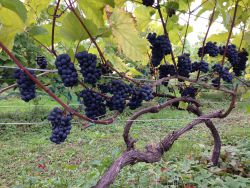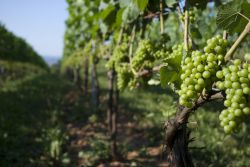Halifax Media Co-op
News from Nova Scotia's Grassroots
Native Grapes and Maritime Wine

GM 318, better known as Geisenheim for the German town where the hybrid grape was bred, is doing well in Nova Scotia, making light wines reminiscent of Riesling. This vine, at Avondale Sky Winery, is one of the oldest in the province. photo: Moira Peters
Why hybrids make sense, and some promising varieties to watch for
"Love the one you're with."
–Stephen Sills, folk rocker
Wineries only started making wine from grapes grown in the Maritimes in the 1980s. The wine was good, at least good enough that it made sense to develop wine industries in the region. It was always different, however, from wine being made in the rest of the world.
This difference is fundamental: the species of grapes that were used, which bore names like Marechal Foch and Michurinetz, was not the same species that goes into most of the world's wine. Most wine is made from grape varieties of the European species vitis vinifera, which does very well in Mediterranean environments. It includes all the varieties we are familiar with (and many that we're not): Chardonnay and Chasselas, Cabernet Sauvignon and Sauvignon Blanc, Malbec and Grenache and Gamay.
These grapes do not do so well in the Maritimes. They are not used to our freezing winters and will suffer winterkill—die or be severely injured—if it gets below minus 15 to 20 degrees Celsius for any amount of time. Many vinifera also require growing seasons to be warmer than ours in order for them to ripen properly. (Unripe wine tastes thin, green, bitter and imbalanced.)
There are, however several species of grape native to North America, such as vitis riperia, vitis rupestris and vitis labrusca. These grapes like the cold just fine and ripen enough that birds and other animals find them delicious and spread their seeds, but they do not make very good wine. Nevertheless, they have played an important role in the global wine industry.
In the 1860s, a louse called phylloxera invaded and destroyed the precious vineyards of Europe, and spread to vineyards all around the world. Only a few regions, such as Chile, protected by the defensive geography of the Andes mountain range, and South Australia, protected by proactive import, export and interstate shipping laws, managed to stay phylloxera-free. (As a result, these regions have some of the oldest grapevines in the world.)
The tough North American grape species were resistant to phylloxera. With great hope, French grape breeders began crossing North American species with their beloved European vinifera varieties, creating new hybrid grape varieties like Lucie Kuhlmann, Seyval Blanc and Vidal Blanc. They hoped these grapes, which carry genes that make them largely unaffected by phylloxera, would also carry genes that create in wine the aromas, flavours and textures they loved so much.
In the meantime, those same grapes, because of their North American genes, turned out to be very winter hardy and were able to fully ripen in a cool growing season. Maritimes wine producers have since built industries around these French-American hybrids, and grape growers and wine makers have been working with them since the late 1970s and early '80s, figuring out suitable sites and optimal viticultural and vinification practices for using grapes which are, relatively speaking, new to the world.
This makes a lot of sense for a wine industry in the Maritimes. We don't have the economies of scale to mechanize—most vineyards in the Maritimes are five acres or less–so it is expensive to produce grapes. Grape growers here are not getting rich—far from it. Most subsidize their growing with a second family income. Therefore, the less a farmer has to replace vines because of winterkill and the greater the volume of grapes that will ripen on a given vine, the more financially viable it is to maintain a vineyard.
In spite of their disease resistance and hardiness, hybrids have not taken the wine world by storm. The French (and other Europeans) were so disappointed with the results from the hybrid grapes they bred in the late 1800s and early 1900s that some European countries have outright banned the commercial planting of hybrid grapes. This disappointment has spread around the wine world and morphed into a disdain for hybrid grapes that has stuck.
While it is true that wine made from hybrid grapes is, generally, different from vinifera wines, this doesn't mean it is necessarily inferior. Difference is okay. After all, the enjoyment of wine is subjective, and shouldn't depend on what species the grape comes from. (Unfortunately, it often does. Critics will rave about a wine they taste blind, but once they learn it comes from a hybrid grape they will automatically score it lower than a vinifera wine that did not show as well blind.)
Hybrid wines tend to be higher in acid (making them food-friendly), lower in alcohol (making them lighter in body), lower in tannin (giving them less of the dry-your-gums, mouth-filling sensation predominant in some reds) and some, particularly reds, tend to smell and taste like vegetables. Whether or not these characteristics float your boat, they have come to be a part of what wine means in Atlantic Canada. They have become part of our terroir.
Culturally, Maritimers are beginning to recognize wine with names like l'Acadie Blanc, Baco Noir and Marechal Foch. And while the rest of the world turns up its nose at these grapes, we embrace them; they are the wines of home.
Some European grapes do grow here. Hardy, early-ripening vitis vinifera such as Chardonnay, Pinot Noir, Pinot Meunier, Cabernet Franc, Riesling and more recently Gewürztraminer and even the very difficult Sauvignon Blanc are being cultivated in some moderate sites in Nova Scotia. This trend is growing; vinifera wines are simply better sellers (people recognize the names) and they do make lovely wine.
The grape trend is also moving in the other direction. More and more of Atlantic Canada is being planted in grapes, and as this crop expands into cooler regions like New Brunswick and Newfoundland, growers are looking for varieties that will survive harsher climates. Hybrids developed in Minnesota, New York and Ontario are becoming popular for their extreme winter hardiness and ability to fully ripen with less heat.
Osceola Muscat (an aromatic white), Marquette (a light red, related to Pinot Noir) and Frontenac Gris (a white) are a few grapes, bred in North America, that have been successful in vineyards and wineries here. Some even newer ones—Petite Pearl (a red), Petite Milo (a white) and Louise Swenson (a white)—are a few others to keep an eye out for in the future.
The work of finding new grape varieties for the viticultural margins is happening even closer to home. The Kentville Research Station in Nova Scotia's Annapolis Valley has been breeding grapes since 1913 and today, though the program is relatively small, it is doing cutting-edge genetic screening (not to be confused with genetic modification) research into varieties that will grow well and make delicious wine. This screening allows breeders to identify whether seedlings have the genes they want to keep—genes that will make a grape resistant to powdery mildew, for example—without having to spend four years growing the vine until it produces grapes that can be made into wine and only then find out whether or not the experiment yields anything worthwhile.
This work is not just important to wine producers looking for a successful product and wine lovers looking for their new favourite local wine. Grapes that suit our region—that are disease resistant and that naturally thrive in our soils and climate—don't need the chemical fertilizers and fungicides that do grapes not naturally suited to our environment.
Embracing new grape varieties is also important in increasing diversity in vineyards. Species diversity is a way to encourage a balanced environment where disease has a harder time spreading. This message of diversity is particularly important in a world that is, historically and culturally, extremely resistant to variation. Like a smoker's brand, wine styles are fixed in many wine lovers' minds and palates.
Winemakers in this region recognize that, although their wines may not carry the names of great world wines, they are still high quality, with bright, clean, aromatic profiles. These producers are not trying to make our grapes into something that looks, smells and tastes like it came from France or California—nor should they. Rather, they are working with what is right in front of them, making that extra effort to find an honest expression of what grows well in fields and on our hillsides.
If you haven't already checked out some of the variety available in your own back yard, make this Valentine's Day an opportunity to take some extra time getting to know the wine that is being made down the road. You may find you love something that was there all along, right under your nose.
The site for the Halifax local of The Media Co-op has been archived and will no longer be updated. Please visit the main Media Co-op website to learn more about the organization.




